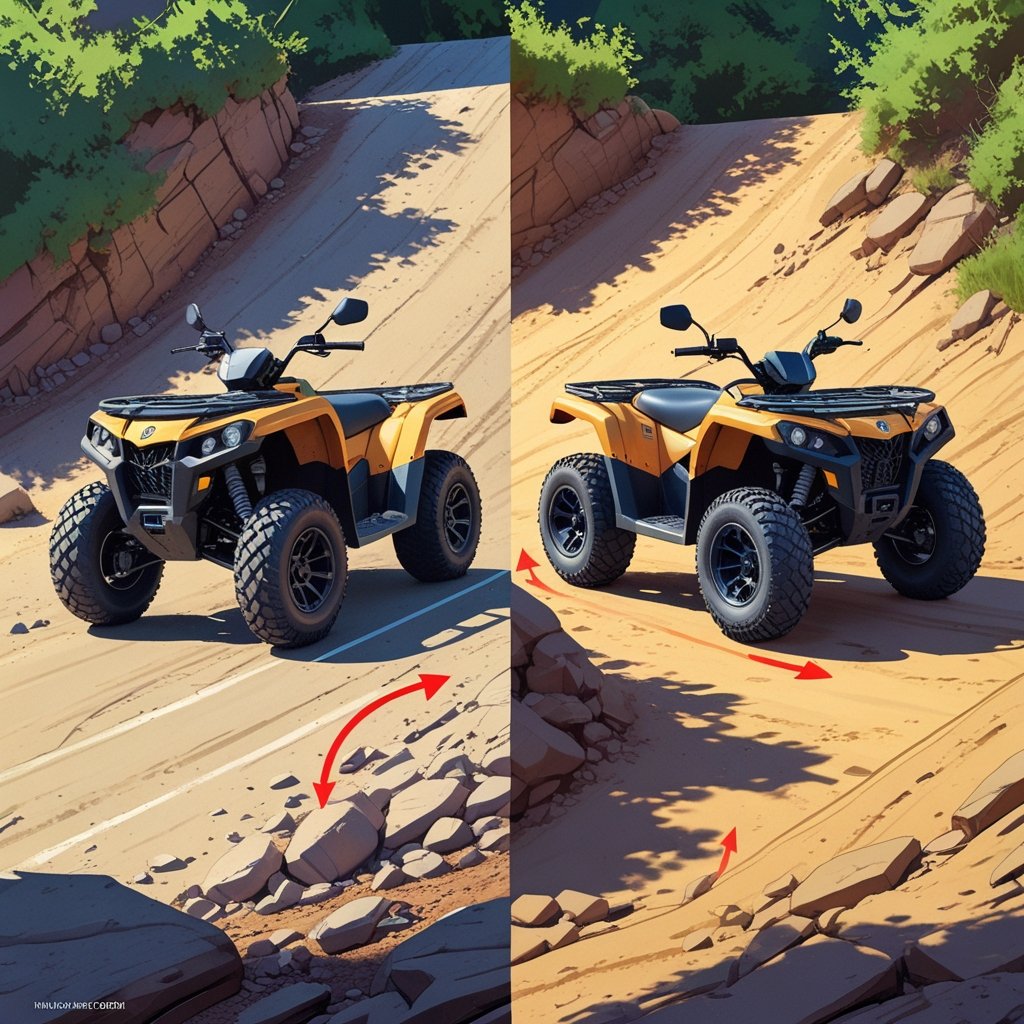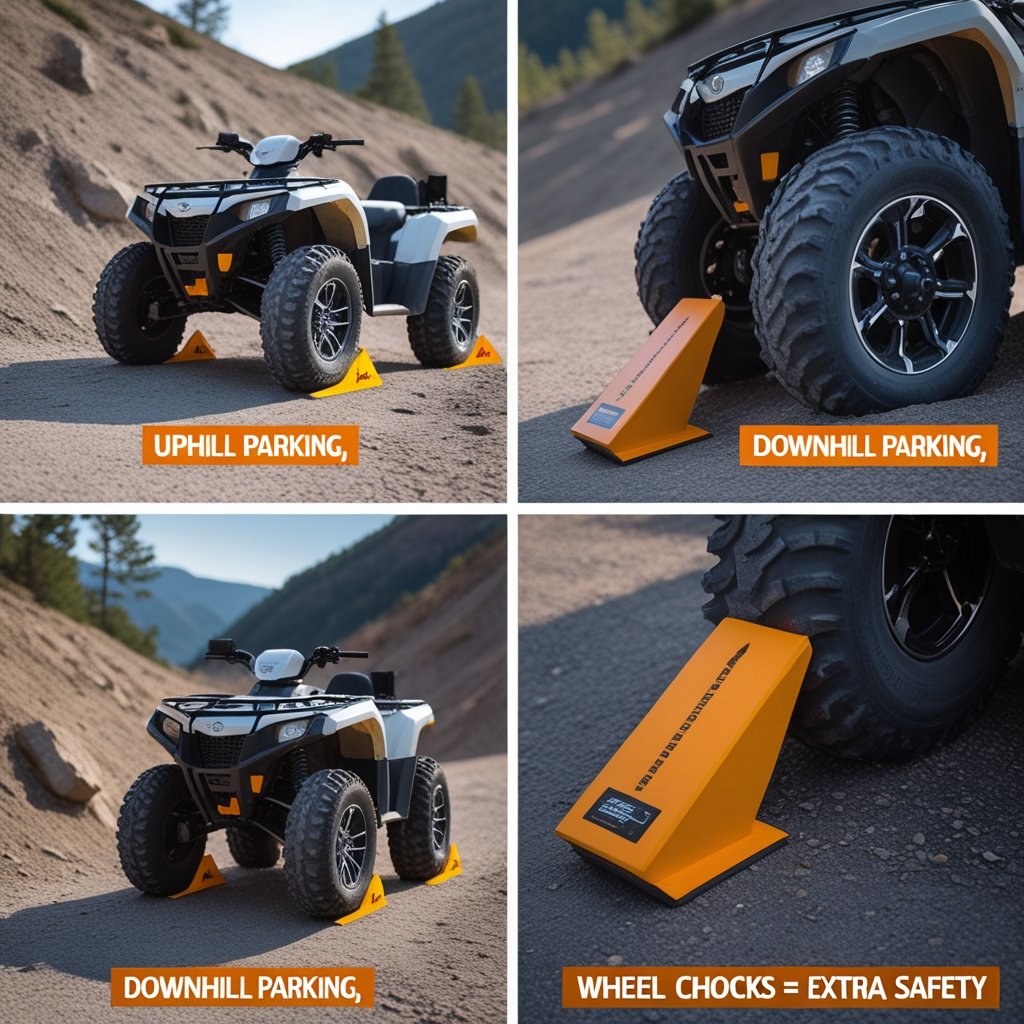There you are – you’ve navigated a challenging trail, climbed to a breathtaking viewpoint, and you’re ready to hop out, stretch your legs, and soak in the scenery. But wait… the only spot to park is on a noticeable slope.
Suddenly, that simple act of parking your UTV feels a bit more consequential. Will it stay put? Did I set the brake correctly? Is ‘Park’ really enough on this grade? That little seed of doubt can quickly spoil the moment.
Parking on level ground is second nature, but mastering UTV hill parking safety requires a more deliberate approach.
It’s not just about preventing your machine from rolling away (though that’s paramount); it’s about protecting your transmission, ensuring your own safety when getting in and out, and avoiding a potentially dangerous and difficult recovery situation.
Relying solely on the transmission’s park pawl on an incline is a gamble many experienced riders refuse to take.
So, let’s ditch the anxiety and replace it with confidence.
This guide will walk you through the essential steps and considerations for secure UTV hill parking safety.
From assessing the terrain to the proper sequence of setting brakes, turning wheels, and using chocks, we’ll cover the techniques you need to ensure your UTV stays exactly where you intended, no matter the angle.
The Gravity of the Situation: Risks of Parking on Hills
Why all the fuss about parking on a slope?
Gravity is relentless, and it introduces several risks specific to UTV hill parking safety:
- Transmission Strain: As we’ve discussed before (check out our post on Why You Need a UTV Parking Brake Lock), relying only on the ‘Park’ setting puts immense stress on the small park pawl within your transmission. On a hill, this stress is magnified significantly, increasing the risk of wear or outright failure over time.
- Roll-Away Hazard: This is the most immediate and dangerous risk. If the park pawl fails, the parking brake isn’t set properly, or the ground is unstable, your UTV could start rolling. This poses a serious threat to anyone downhill, can cause catastrophic damage to your machine, and could damage property or the environment.
- Instability: Slopes often mean uneven ground. Parking on an off-camber section of a hill can make the UTV inherently less stable and more prone to tipping if it does start to move or if someone bumps it while getting in or out.
- Difficulty Recovering: Trying to safely recover a multi-thousand-pound UTV that has rolled partway down a hill is incredibly difficult and dangerous. Preventing the roll in the first place is vastly preferable.
The Hill Parking Safety Checklist: Step-by-Step
Think of this as your go-to procedure every time you need to park on an incline.
Following these steps methodically is key to UTV hill parking safety.
1. Assess the Terrain & Choose Your Spot Wisely
Before you even stop, scan the area. Look for the least steep and most stable spot available, even if it’s not the absolute closest to where you want to be.
Check the ground surface – is it firm soil, loose gravel, mud, or wet grass? Avoid parking on overly soft or unstable shoulders where a tire could sink or slip.
Also, note any potential hazards downhill – ledges, large rocks, trees, or water bodies you definitely don’t want to roll into.
2. Position Your UTV Correctly
Whenever possible, try to park your UTV facing either straight uphill or straight downhill.
Parking perpendicular (sideways) to a steep slope significantly increases the risk of a rollover if the vehicle starts to slide or settle. Minimize the sideways tilt as much as possible.
3. Engage the Brakes – Your First Line of Defense
This is non-negotiable. Before shifting into Park and before turning off the engine:
* Apply Service Brakes Firmly: Press down hard on the foot brake pedal to bring the UTV to a complete stop and hold it there.
* Engage Parking Brake / Lock: While still holding the foot brake, securely set your factory parking brake (if you have one and trust it) OR, much more reliably, engage your aftermarket UTV parking brake lock. This mechanically holds the hydraulic brakes applied, taking the primary load.
4. Turn Wheels Appropriately (The Curb Rule)
This simple technique, borrowed from road driving but equally applicable off-road, uses the terrain itself as a potential backstop:
* Facing Downhill: Turn your front wheels towards the curb, trail edge, or downhill shoulder. If the brakes were to fail, the UTV should roll into the edge/curb and stop, rather than rolling straight down the trail or into an open area.
* Facing Uphill (with a solid edge/curb): Turn your front wheels away from the curb/edge. Allow the UTV to roll back just an inch or two until the rear of the front tire makes gentle contact with the solid edge. The edge now acts as a chock.
* Facing Uphill (without a solid edge/curb): Turn your front wheels towards the side/edge of the trail or shoulder. If the UTV rolls backward, it should angle off the trail rather than rolling straight back down it.

5. Shift to Park (or Low Gear)
After the brakes are securely set and the wheels are turned, shift the transmission into Park.
Think of this as a backup system, not the primary holding force. For UTVs with manual transmissions, engage Low gear.
6. Turn Off the Engine
Never leave your UTV running unattended, especially when parked on an incline.
7. Chock the Wheels – The Ultimate Backup
For maximum UTV hill parking safety, especially on steeper grades or for longer stops, use wheel chocks.
Place sturdy chocks snugly against the downhill side of at least one tire, preferably two tires on opposite sides of the vehicle.
Use purpose-built wheel chocks made of rubber or polyurethane – don’t rely on rocks or logs, which can easily slip or roll.

Safe Dismounting and Re-entry on Slopes
Your safety doesn’t end once the UTV is parked. Always try to exit and enter the vehicle on the uphill side.
If the machine were to shift, roll, or tip unexpectedly, you want to be out of its potential path. Be extra careful with your footing on the sloped, potentially uneven ground.
When getting ready to leave, ensure everyone is securely seated before starting the engine and releasing the brakes and chocks.
Be ready to control the vehicle immediately as the holding forces are removed.
What NOT to Do When Parking on Hills
Avoid these common mistakes that compromise UTV hill parking safety:
* Never rely solely on the transmission’s Park setting. *
Avoid parking sideways across very steep slopes if at all possible. * Don’t leave the engine running while the vehicle is unattended.
* Don’t forget to turn the wheels correctly and use chocks on significant inclines. * Always dismount/enter on the uphill side.
* If the UTV starts to roll backward unexpectedly, apply brakes gently and steadily – slamming them on could potentially cause instability or even a flip, especially if only rear brakes engage strongly.
Conclusion: Park Safe, Stay Safe!
Parking your UTV on an incline doesn’t need to be a source of stress.
By understanding the risks and consistently applying the proper UTV hill parking safety procedures, you can confidently secure your machine.
Remember the checklist: assess the terrain, position correctly, firmly set the brakes and/or parking brake lock, turn the wheels appropriately, shift to Park as a backup, turn off the engine, and use wheel chocks for added security.
These steps might seem like a bit more effort than just throwing it in Park, but they are crucial for protecting your valuable investment, preventing dangerous roll-aways, and ensuring your own safety and the safety of others around you.
Make UTV hill parking safety a habit every time you encounter a slope.
Invest in a good parking brake lock and a set of wheel chocks – they are inexpensive insurance against potentially catastrophic failures.
Practice the techniques, stay vigilant, and enjoy those incredible elevated views responsibly!




![Wheel Chocks [2pair/4pack with Rope] for RV Trailer Camper Truck ...](https://m.media-amazon.com/images/I/41q2Y29YvLL.jpg)









